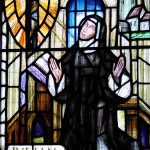 Note: Today’s post, by guest contributor Fr. Ronald Rolheiser, is an excerpt from his new book, Bruised and Wounded: Struggling to Understand Suicide. This may seem to be a difficult topic for the Advent season, but as anyone knows who has been touched by suicide (or even by the sudden death of a loved one, under any circumstances), loss and grief can be particularly acute during this time of year. So I’m honored to offer you Fr. Rolheiser’s thoughts on a very challenging subject.
Note: Today’s post, by guest contributor Fr. Ronald Rolheiser, is an excerpt from his new book, Bruised and Wounded: Struggling to Understand Suicide. This may seem to be a difficult topic for the Advent season, but as anyone knows who has been touched by suicide (or even by the sudden death of a loved one, under any circumstances), loss and grief can be particularly acute during this time of year. So I’m honored to offer you Fr. Rolheiser’s thoughts on a very challenging subject.
It’s hard to say something consoling in the face of death, even when the person who died lived a full life and died in the best of circumstances. It’s especially hard when the one who’s died is a young person, still in need of nurturing and care in this life, and when that young person dies in less-than-ideal circumstances.
As a priest, I have a number of times been asked to preside at the funeral of someone who died young, either as the result of illness, accident, or suicide. Such a funeral is always doubly sad. I remember one such funeral, in particular.
A high-school student had died in a car accident. The church was over-packed with his grieving family, friends, and classmates. His mother, still a young woman herself, was in the front pew, heavy with grief about her loss, but clearly weighed-down too with anxiety for her child. After all, he was still just a boy, partly still in need of someone to take care of him, still needing a mother. She sensed how, dying so young, in effect, orphaned him.
There aren’t many words that are helpful in a situation like this, but the few that we have say what needs to be said – even if on that day, when death is still so raw, they don’t yet bring much emotional consolation. What’s to be said in face of a death like this? Simply that this young boy is now in more-loving, more-tender, gentler, and safer hands than ours, that there’s a mother on the other side to receive him and give him the nurturing he still needs, just as there was one on this side when he was born. No one is born, except into a mother’s arms. That’s an image we need to keep before us in order to more healthily imagine death.
What, more precisely, is the image? Few images are as primal, and as tender, as that of a mother holding and cradling her newborn baby. Indeed, the words of the most-renowned Christmas carol of all time, “Silent Night,” were inspired by precisely this image. Joseph Mohr, a young priest in Germany, had gone out to a cottage in the woods on the afternoon of Christmas Eve to baptize a newborn baby. As he left the cottage, the baby was asleep in its mother’s lap. He was so taken with that image, with the depth and peace it incarnated, that, immediately upon returning to his rectory, he penned the famous lines of “Silent Night.” His choir director, Franz Gruber, put some guitar chords to those words and froze them in our minds forever. The ultimate archetypal image of peace, safety, and security is that of a newborn sleeping in its mother’s arms. Moreover, when a baby is born, it’s not just the mother who’s eager to hold and cradle it. Most everyone else is too.
Perhaps no image then is as apt, as powerful, as consoling, and as accurate in terms of picturing what happens to us when we die and awake to eternal life as is the image of a mother holding and cradling her newborn child. When we die, we die into the arms of God and surely we’re received with as much love, gentleness, and tenderness as we were received in the arms of our mothers at birth. Moreover, surely, we are even safer there than we were when we were born here on earth. I suspect too that more than a few of the saints will be hovering around, wanting their chance to cuddle the new baby. And so it’s okay if we die before we’re ready, still in need of nurturing, still needing someone to help take care of us, still needing a mother. We’re in safe, nurturing, gentle hands.

About the author: Ronald Rolheiser is a Catholic priest with the Missionary Oblates of Mary Immaculate, and an internationally renowned speaker and spiritual writer. He is the author of several books including the New York Times bestseller, The Holy Longing. He is president of the Oblate School of Theology in San Antonio, Texas. Visit www.ronrolheiser.com to learn more.
Enjoy reading this blog?
Click here to become a patron.
Stay in touch! Connect with Carl McColman on Facebook:














